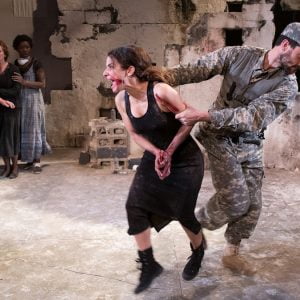This is the fourth interview in a series with emerging female live performance designers. In this interview APDG member Antoinette Barbouttis interviews Melanie Liertz – about designing and making for theatre, opera, film, dance and circus. Melanie’s work ranges from designing Captain Hook’s Pirate Party (Sydney Opera House), to the war-ravaged set for Sport for Jove’s Antigone, to an innovative, ability-sensitive design for Shopfront’s Dignity of Risk. Melanie is also a costume designer and maker in theatre and film and set designer for Pinchgut Opera’s production of Handel’s Athalia.
This series of interviews have been republished here with the kind permission of Audrey online journal.
AB: Do you find it difficult to wrap your ears around opera as a designer?
ML: No, because I have a background in classical music. I love it. I’ve been listening to Handel for as long as I can remember. My parents are classical musicians, so opera isn’t a foreign genre to me. I can read a score. It’s a seamless blend of music and design. But to enjoy opera, and to feel opera, you don’t need a set of trained ears. The human voice, raw on stage, is so visceral. Athalia is amazing. It’s a beautiful choral work. I work next to the rehearsal room and get to listen to it all day. The drama and the music are so intertwined. They are one world. For me, the extra-emotive form extends to an embellished, big design. In that respect, Baroque opera hasn’t changed.
AB: It’s a female-driven libretto with some pretty large female characters. Yet it’s not a love story.
ML: There’s a face-off between the two lead women, Athalia and Josabeth, and two vastly different and equally strong characters are explored. The battle requires the audience to draw their own conclusions because there is no definitive resolution to the show. It’s a big, biblical story that allows me to pull from so many references. We’ve created a whole world that’s both familiar and heightened.
AB: I feel from seeing your designs that you are a doer, as in: ‘Mel gets the job done ….’ How have you resolved practical design decisions over the years?
ML: I am a doer! I tend to think up solutions I can physically do myself. I can build. I can sew. I’m a practical, lateral thinker. But if there are objects that need to take weight, that are required to be structurally sound – a staircase, for example, or a swing – I always think about what the worse-case scenario could be with a self-built design, and plan that it might happen.
I’ve had eyes from the Pinchgut team over the Athalia design, making things possible that I personally would not be able to physically realise in another production. I’ve been able to put on my designer cap. I’ve been in this closed box of my own design thinking for 15 years, coming up through the independent scene.
AB: Looking back at some of your work, I really enjoyed Dignity of Risk. The show was the first I’ve seen in Sydney that incorporated design for the visually impaired. I think it was a triumph. How did it develop?
ML: The process was interesting. It was a show that was devised over long periods of time and I was brought into the process quite late. In a way, I was given an opportunity to provide a through-line. It was a creatively mutual experience, with the creative team seamlessly crossing fields into lighting and sound. Functionality was exceptionally fun to explore.
It was such a personal success. Being a devised show approached from complete openness – none of us knew the outcome and it ultimately reached a whole new audience.
AB: How long has it taken you to get to this stage of your career?
ML: Athalia is the first show that has been an ideal situation – the ideal situation being a reasonable fee, when you break down the show to the hours spent on it. Generally, I try not to do that, but this is the first time that if I did, I’d be on minimum wage, which is something to be excited about.
It’s nice to finally be paid for ideas and I hope it’s a comfortable rolling career, but I don’t know if it will be. I can attribute a lot of this paid work to Antigone, a work I realised essentially on my own, alongside a scenic artist.
If I didn’t have a partner who covered me, I wouldn’t be able to do this work. This model limits the people we see in this industry to those who are financially supported. We shouldn’t limit the voices we see. I acknowledge how lucky I am, but I have sacrificed security and I’ve given up ideas of retirement or being able to take sick leave. I’ve taken a massive pay-cut by choosing this career. My life is my job.
Antoinette Barbouttis



